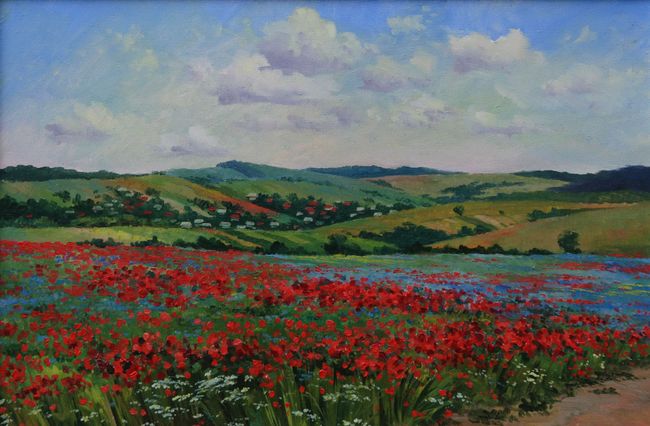“His imagined environments host some important ‘cosmic’ cycles, whose meaning can only be explained by fine poets, like the creator himself.” These lines do not describe some writer, but Drohobych-based artist Levko Mykytych, as seen by rector of Lviv Academy of Arts, Professor Roman Yatsiv. His statements deserve our trust, for Yatsiv, being an art critic, a prominent artist, and, last but not least, The Day’s contributor, discerned probably the most significant feature of Mykytych’s work in his observations on the latter: a poetic perspective combined with lyricism and a philosophical vision of the world. Mykytych is well known in the circles of connoisseurs of fine arts, as he is a member of the National Union of Artists of Ukraine, teaches arts at Emmanuil Mysko Pidbuzh Minor Academy of Arts, is a member of Drohobych Artists Association and a participant of many exhibitions, including solo ones. By the way, an exhibition of his paintings was recently held at the Veles Gallery in Lviv, and about 90 of the master’s works have gone on display at the Taras Shevchenko Museum in Kyiv. These are his present achievements, coming after a long and purposeful artistic career, which started in his native village of Nahuievychi, better known as Ivan Franko’s birthplace. For early detection and development of creative abilities of a young person, teacher is all-important. Mykytych was lucky to have as one of his first teachers the founder and director of children’s art school in Drohobych, the founder of the “visialism” style Peter Heydeck. Under his direct supervision and influence, several outstanding natives of Drohobych made their mark in the arts, but this is a story for another day. Heydeck lives in Cologne (Germany) now, and current information about him can be accessed at www.peter-heydeck.net. Mykytych continued his training in Lviv, graduating from the Trush School of Applied and Decorative Arts. His Lviv teachers, including Mykhailo Drahan and Petro Markovych, instilled the youth with great ideals and traditions of the Lviv school of painting. He added to his life and creative experience in his Moldova years (1990-98), where the artist participated in particular in exhibitions held by the Vidrodzhennia Society of Ukrainian Artists of Moldova. Mykytych then returned to Drohobych to teach and... paint new works, full of creative anxiety and quest for his own style, character, and new horizons. It is not necessary to emphasize that every conscious artist seems to think about such things, but those trying to describe his achievements often stressed these qualities in his work. As art critic Lada Tsymbala wrote, his paintings borrowed their imagery from “the Boiko Land tradition of folk art and picturesque Carpathian landscapes.”
It is true that landscapes occupy an important place in Mykytych’s oeuvre, but from the 2000s, it has featured special characteristics that complement or even replace the traditional “picturesque” treatment of the Carpathians’ natural beauty with alarming signs of internal disagreement and awareness of unpredictable changes in nature. We discussed above poetic and philosophic perspective of the artist that reflects the environment, whether realistically or in an abstractionist matter. As for “abstraction,” that is, the introduction to paintings of strange or seemingly obscure details, features that are supposedly absent from real life, it seems superfluous to discuss it anymore in the early 21st century: has not everything been discovered in the arts by now?! However, reality is entirely different: new generations of artists discover new imagery not only in the visual arts, but also in music and literature. They often base their works on ethnic or even sub-ethnic roots that suggest new stories to them (the Boiko Land, for example, is populated by a highly distinct sub-ethnic branch of Ukrainians).

NAHUIEVYCHI. POPPIES IN BLOOM (1999)
One of Mykytych’s paintings is entitled Life Is Raging. It seems to reflect the artist’s worldview, who, having gone through the hell of the Soviet-Afghan war, knows the value of life: people should keep living even in the most difficult times, and a philosophical perspective makes reality easier, or possibly more bearable, or better. According to penetrating painting critic Yatsiv, “Mykytych is one of the most talented and original artists embodying the idea of universality of this great spiritual and cultural complex in its historical perspective, as he reveals the soul of this land so harmoniously through his own existence.”







